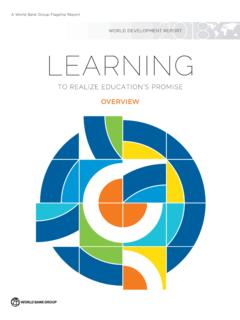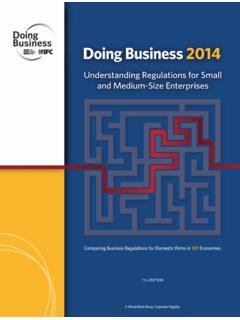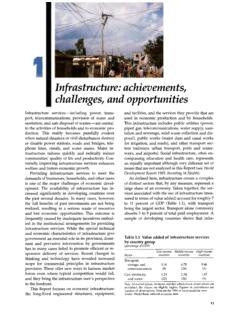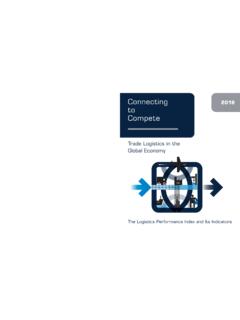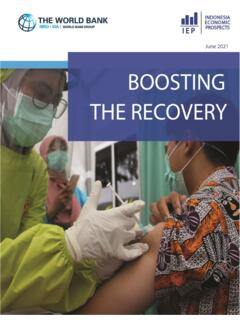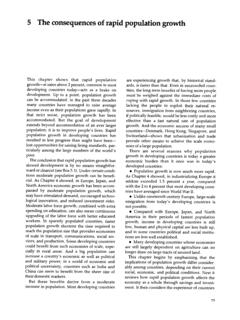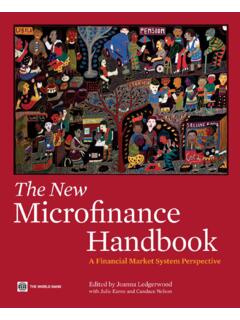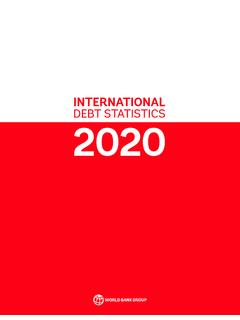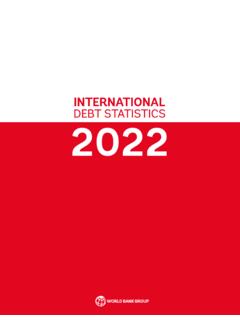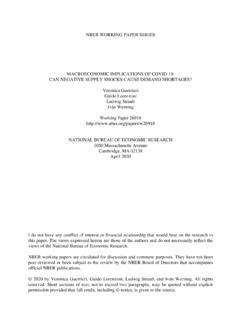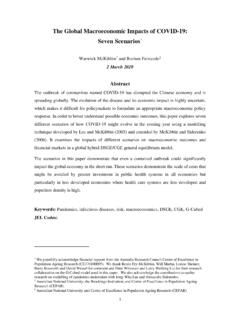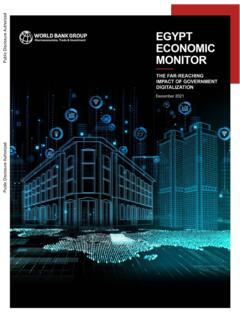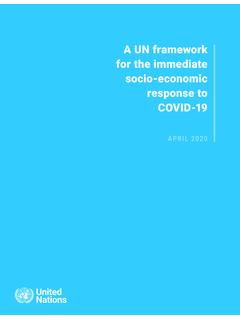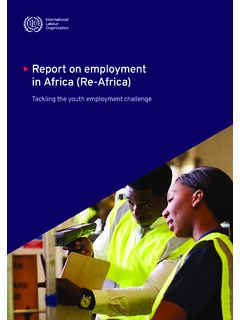Transcription of The African Continental Free Trade Area - World Bank
1 THE. African Continental . free Trade area . Economic and Distributional Effects The African Continental free Trade area The African Continental free Trade area Economic and Distributional Effects 2020 International Bank for Reconstruction and Development / The World Bank 1818 H Street NW, Washington, DC 20433. Telephone: 202-473-1000; Internet: Some rights reserved 1 2 3 4 23 22 21 20. This work is a product of the staff of The World Bank with external contributions. The findings, interpretations, and conclusions expressed in this work do not necessarily reflect the views of The World Bank, its Board of Exec- utive Directors, or the governments they represent. The World Bank does not guarantee the accuracy of the data included in this work. The boundaries, colors, denominations, and other information shown on any map in this work do not imply any judgment on the part of The World Bank concerning the legal status of any territory or the endorsement or acceptance of such boundaries.
2 Nothing herein shall constitute or be considered to be a limitation upon or waiver of the privileges and immunities of The World Bank, all of which are specifically reserved. Rights and Permissions This work is available under the Creative Commons Attribution IGO license (CC BY IGO) http://creative- Under the Creative Commons Attribution license, you are free to copy, distrib- ute, transmit, and adapt this work, including for commercial purposes, under the following conditions: Attribution Please cite the work as follows: World Bank. The African Continental free Trade area : Economic and Distributional Effects. Washington, DC: World Bank. License: Creative Commons Attribution CC BY IGO. Translations If you create a translation of this work, please add the following disclaimer along with the attri- bution: This translation was not created by The World Bank and should not be considered an official World Bank translation.
3 The World Bank shall not be liable for any content or error in this translation. Adaptations If you create an adaptation of this work, please add the following disclaimer along with the attribu- tion: This is an adaptation of an original work by The World Bank. Views and opinions expressed in the adaptation are the sole responsibility of the author or authors of the adaptation and are not endorsed by The World Bank. Third-party content The World Bank does not necessarily own each component of the content contained within the work. The World Bank therefore does not warrant that the use of any third-party-owned individual com- ponent or part contained in the work will not infringe on the rights of those third parties. The risk of claims resulting from such infringement rests solely with you. If you wish to reuse a component of the work, it is your responsibility to determine whether permission is needed for that reuse and to obtain permission from the copyright owner.
4 Examples of components can include, but are not limited to, tables, figures, or images. All queries on rights and licenses should be addressed to World Bank Publications, The World Bank Group, 1818 H Street NW, Washington, DC 20433, USA; e-mail: ISBN (paper): 978-1-4648-1559-1. ISBN (electronic): 978-1-4648-1560-7. DOI: Cover illustration: Guillermo Varela and Estudio Prado Cover and interior design: Kirsten Dennison Library of Congress Control Number: 2020942433. Contents Foreword IX. Acknowledgments XI. About the Authors XIII. About the Contributors XV. Abbreviations XIX. OVERVIEW 1. Data and methodology 1. Macroeconomic impacts of AfCFTA 3. Distributional impacts of AfCFTA on poverty and employment 5. The African Continental free Trade area is a key to help Africa address the challenges of covid -19 7. Caveats 8. References 9. 1 INTRODUCTION 11. Notes 13. Reference 14. 2 THE CONTENT OF AfCFTA AND African SUBREGIONAL Trade AGREEMENTS 15.
5 Notes 18. References 19. 3 LITERATURE REVIEW 21. References 22. 4 DATA AND METHODOLOGY 25. Data 25. Global dynamic computable general equilibrium model 25. Distributional impacts of AfCFTA 26. Trade facilitation 37. Notes 38. References 39. v vi Contents 5 MACROECONOMIC IMPACTS OF AfCFTA 41. Real income implications 43. Trade implications 46. Output implications 52. Government revenue implications 54. Notes 55. References 55. 6 DISTRIBUTIONAL EFFECTS OF AfCFTA ON POVERTY AND EMPLOYMENT 57. Effects on poverty 57. Effects on employment 59. Notes 67. References 67. 7 SENSITIVITY ANALYSIS 69. 8 CAVEATS 71. Notes 72. Appendix A: Data Preparation on Disaggregated Labor Volumes and Wages 73. Appendix B: Summary Description of the GIDD Model 81. Appendix C: Deep Commitments in African Regional Economic Communities, Legal Texts 87. Appendix D: Literature Review on the Impacts of AfCFTA 93. Appendix E: Recent World Bank Research on Regional Integration in Africa 97.
6 Appendix F: Data Sources 101. Appendix G: Summary Description of the ENVISAGE Model 107. Appendix H: Statutory Tariff Data Availability by Country 119. Appendix I: Maximizing the Potential Benefits of the African Continental free Trade area 121. Appendix J: Short-Term Revenue implications of Tariff Liberalization under AfCFTA 127. Boxes The importance of small-scale cross-border Trade in Africa 27. The impact of covid -19 on economic activity in Sub-Saharan Africa 42. Wages and employment under AfCFTA in C te d'Ivoire 64. Maximizing the potential benefits of a free Trade agreement 123. Available World Bank Group support to maximize the potential benefits of AfCFTA 125. Figures Real income gains, by country and policy reform 4. Evolution of extreme and moderate poverty under baseline and AfCFTA implementation, 2015 35 6. AfCFTA member countries, by status of ratification 12. Contents vii Trade , GDP, and population of African continent as share of global total 13.
7 Female employment intensity in disaggregated labor database, AfCFTA countries 28. Projected employment by gender and skill: North Africa and Sub-Saharan Africa, 2020 and 2035 29. Share of imports and average tariffs imposed on AfCFTA imports 32. Trade -weighted tariffs imposed on AfCFTA imports by country, 2020 and 2035 33. Trade -weighted tariffs imposed on AfCFTA imports by sector, 2020 and 2035 34. Trade -weighted nontariff barriers imposed on AfCFTA imports by country, 2020 and 2035 35. Trade -weighted nontariff barriers imposed on AfCFTA imports by sector, 2020 and 2035 36. Equivalent variation, percentage relative to baseline, 2035 44. Total exports from Africa, deviation from baseline, 2035 50. Total imports from Africa, deviation from baseline, 2035 51. Output difference relative to baseline, 2035 52. Evolution of extreme and moderate poverty under baseline and AfCFTA. implementation, 2015 35 58. AfCFTA employment change with respect to baseline, total and female 61.
8 Effects of AfCFTA on wages by skill 62. Effects of AfCFTA on wages by gender 63. C te d'Ivoire: Labor composition by skill and gender: AfCFTA, 2035 64. C te d'Ivoire: Labor volumes by skill and gender, 2020 and 2035 65. C te d'Ivoire: Effects of AfCFTA on wages by industry 66. C te d'Ivoire: Effects of AfCFTA on wages by skill and gender 66. Procedure for establishing wage and employment volume 74. Structure of value added in the production function 109. Taxes on international Trade as percentage of government revenues 128. Share of total tax revenues from imports 129. Average annual change in tariff revenue (average annual percent change) 132. Average annual change in tax revenue (percent of tax revenue) 132. Ratio of statutory to customs import values 136. Imports from AfCFTA countries, statutory and customs 136. Effective tariff rates for AfCFTA countries (weighted average) 137. Tables Overview of policy areas covered in Africa's subregional PTAs and AfCFTA 2.
9 Overview of policy areas covered in Africa's subregional PTAs and AfCFTA 17. Summary of key findings from literature review 21. Employment and wages in Africa, initial simulation parameters 30. Trade facilitation implementation and iceberg Trade costs reductions 38. Percentage deviations from baseline of equivalent variation, exports, and imports, 2035 45. Exports under baseline scenario and AfCFTA 47. Imports under baseline scenario and AfCFTA 48. Impacts of AfCFTA on Trade of member countries, deviation from baseline, 2035 49. viii Contents Real income gains under three scenarios 70. Household surveys used for the construction of wage bill data 75. AVEs of Jafari and Tarr service sectors 103. Mapping of Jafari and Tarr service sectors with model's service sectors 104. Regional dimension 111. Sector dimension 112. GTAP regional concordance 114. GTAP sector concordance 116. Availability of tariff data by country 119.
10 Statutory and collected tariff rates 129. Tariff revenue changes under AfCFTA scenario 130. Tax revenue changes under AfCFTA liberalization scenario 131. Simulation results based on statutory data 133. Import and tariff revenue impacts estimated using customs data and statutory data 135. Foreword The African Continental free Trade area (AfCFTA) provides a unique opportunity for countries in the region to competitively integrate into the global economy, reduce poverty, and promote inclusion. Although Africa has made substantial progress in recent decades in raising living standards and reducing poverty, increasing Trade can provide the impetus for reforms that boost productivity and job creation, and thereby further reduce poverty. AfCFTA can provide this spark. By 2035, we estimate that implementing the agree- ment would contribute to lifting an additional 30 million people from extreme poverty and 68 million people from moderate poverty.
